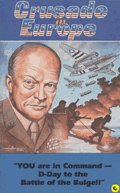
 by GameSpot. Written by Terry Coleman. Re-formatted by Thunderfall on 9/28/00.
by GameSpot. Written by Terry Coleman. Re-formatted by Thunderfall on 9/28/00.
Foreword:
Many of us have played Civilization/Civilization II for a long time. However, I think most Civers don’t know much about Sid Meier. There are just too few articles about Sid on the internet…
I was absolutely thrilled when I stumbled upon this long and detailed article titled “The Sid Meier Legacy” last night. It is about 20 pages in length if you print it out and was written by GameSpot in 1998, before Alpha Centauri was released. Even better, it included a big interview! It’s odd that I missed this article and didn’t see any civ site mention the article back in 1998.
~ Thunderfall, 9/29/2000.
Table of Content
Introduction
Sid Meier isn’t the most talented programmer the world has ever seen. He doesn’t lie awake nights striving for the most exquisitely optimized 3D engine, and you don’t have to own the latest state-of-the-art computer to play his games either – an oddity in an industry obsessed with pushing the envelope almost until it shreds.
But it’s the rare gamer indeed who doesn’t own one – or more likely several – of Sid Meier’s games. The body of Sid’s work can be seen as a microcosm of the industry’s journey from the early Apple and Commodore 64 games to today’s hi-tech PCs, and for that alone it has historical significance. But the reason Sid Meier stands apart from other designers is that many of his older games stand as much more than museum pieces, even in today’s graphics-intensive market: Not only are EGA/VGA titles like Railroad Tycoon and Pirates! still on the shelves, Civilization II is also selling quite well, more than two years after its initial release.
The Sid Meier philosophy has always been to keep the pace of the game moving, and to keep it fun. Throughout his career, Sid has managed, much in the same manner as a good film director or novelist, to cut to the essence of whatever secret he’s letting us in on. As a result, every Sid Meier game is worthwhile, even to those only marginally interested in the subject matter. At a time in his career when most designers would be happy to retire, legacy intact, Sid continues to look for new challenges – like this past year’s Gettysburg and the upcoming Sid Meier’s Alpha Centauri. As long as Sid keeps his passion about crafting games that he wants to play, it’s a good bet that gamers everywhere will share his enthusiasm.
Join us for a tour of Sid Meier’s games, from the early obscure titles to the well-known classics. We’ll even peek into some corners that Sid himself would probably wish would stay hidden, but that’s half the fun, especially when we hear it from Sid himself.
The Formative Years: 1984 to 1989
The legend of Sid Meier begins, appropriately enough, with a tall tale. Sid Meier and Bill Stealey were playing an arcade flight combat game, and Bill – a former military pilot – was amazed that Sid could consistently rack up higher scores.
After humbling Bill (and Stealey being humble about anything is your first clue that this is a fairy tale), Sid pointed out that the AI of the enemy arcade pilot was so predictable that he could easily figure out what it was going to do. Moreover, Sid said he could design a better one, so the story goes, in two weeks. Bill took Sid up on the bet by giving the engineer a job, the two men formed MicroProse, and their vision led them to fame and fortune.
Certainly this makes for a great story, and like most tall tales, it has a kernel of truth at its center. But it’s been more than a little embellished over the years, and it leaves out some critical facts. Sid and Bill kept their day jobs for the first several months, making MicroProse one of many “garage operations” to appear in the budding computer industry in the ’80s. It would be some time before the “Bill and Sid show” became the corporate giant known as MicroProse (and even longer before financial troubles forced MicroProse’s merger with Spectrum HoloByte – but that’s another story).
Needless to say, Sid needed more than a couple of weeks to design the game. Looking back on it, Solo Flight seems primitive, but it was a step up from the pitiful AI common in arcade machines of the era. In that respect, Sid achieved his goal, and the lessons he learned here would serve him in good stead when he moved on to Hellcat Ace (another 1984 release) and later to real flight sims like 1988’s F-19 Stealth Fighter.
Bill Stealey and I were working for General Instrument Corporation. Bill was in business development and I was a systems analyst. I had finally gotten a personal computer – which was the Atari 800 – probably six months before. I had really held off on getting a personal computer because they were all very hardware oriented. But the Atari 800 came out, and it was finally a computer that didn’t have switches and paper tape – you could actually program it – so I got into making some games on it.
I ran into Bill Stealey who is always telling his Air Force stories, so he started telling them. I said, “Well you know, I like computer games and I’m working on one with airplanes in it,” and he said, “Oh? Let’s start a business.” And I said, “Well, that’s an interesting idea.”
We wandered around – this was in Las Vegas – and we dropped by this arcade which had a game called Red Baron, a World War I airplane game. Bill sat down and played it, and he shot down a couple planes, and then he kind of got wasted. Then I sat down and played it, and I shot down a lot more planes. He said, “How did you do that? I’m a hotshot Air Force fighter jockey. You can’t be shooting down more planes than me.” And I said, “Well, I noticed just watching the game that the key is you don’t want to let them get behind you. When they get behind you, there’s no way you can ever shoot them down.” So he said, “Hey, that’s pretty clever.”
There was a bond made there. I think Bill respected the fact that there was maybe more to these computer games, but he was interested in the sales and marketing side, and he had kind of the drive and the personality, and I was interested in the creative side and how these games were put together and what made them tick and what the strategies were and things like that.
So we kind of shortly after that decided to form MicroProse, and it started off very small. The irony is we thought we were behind the curve, that the industry had already peaked, and we were just trying to catch up. This was like 1981, 1982. In hindsight, it was a great time, the timing was excellent. It was still a time when a couple guys in a basement could duplicate their own disks, put them in plastic baggies with a four-page photocopied manual, and actually sell a product like that. It was a great learning experience. I think a lot of what makes me kind of able to keep doing games is the fact that I was there at the beginning and that I don’t have to play catch-up all the time. It’s kind of like I’ve been there since the start, so I’ve seen the evolution and have a bit of a sense of history and perspective.
Silent Service (1985)
If a game such as Silent Service tried to pass itself off as a simulation in today’s realism-and-detail-are-everything market, it would be torpedoed almost before it left port. In 1985, however, action-oriented sims were only a couple of notches more realistic than arcade games, and Silent Service fit the bill quite nicely, becoming MicroProse’s (and Sid Meier’s) first big hit.
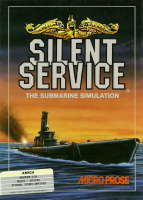
Design: Sid Meier
Publisher: MicroProse
Genre: Action/Simulation
Difficulty: Easy
As the commander of a United States submarine during WWII, you rushed around your vessel doing almost everything yourself: sighting the enemy in your periscope, figuring out a firing solution for your target, and even loading the torpedoes into the tubes. All this activity was hardly appropriate for a captain, but it was fun – and it brought you into intimate contact with your sub in a big hurry. And let’s be fair: It would have been hard for Sid (or anyone else) to have a lot of high-detail crew members taking orders and running around the screen on a Commodore 64, the launch platform for this game.
The WWII missions were interesting but featured neither the defining campaign of Sid’s later Gunship nor the gritty realism of Red Storm Rising. The sequel, Silent Service II, improved on a lot of Meier’s concepts and added much-improved graphics and sound. But it would be a mistake to simply dismiss the original. Silent Service is a perfect example of Sid’s philosophy of “when fun and realism clash, fun wins.”
Submarine games were all the rage in 1985, and while most of them are now forgotten, gamers remember Silent Service fondly. With this game, Sid began to emerge as a designer who could bring a fresh approach to any genre, a talent that would serve him well for the rest of his career: a good example would be 1997’s Sid Meier’s Gettysburg.
MicroProse was a pretty linear evolution. We expanded by a factor of about three [employees] every year for quite a while. We started off with basically me writing the games, and I had a couple of my friends doing conversions (we all had day jobs; this was kind of our hobby). In those days, I was doing the Atari [conversion], but we also had to convert to Commodore, Apple, Sinclair; there was a whole bunch of machines running around. We gradually hired people. I think Andy Hollis, who now works at Origin, was the first programmer that came on board. We hired a salesperson. It was a pretty linear growth.
For the first year or so, we weren’t sure where things were going, so we tried to use part-time people, but after that, we hired full-time people. MicroProse was one of the first companies to go to Europe and set up its own sales and marketing organization and start to build the European market. It helped MicroProse a lot. They were actually distributing products from other companies. But the early years were a pretty steady growth, reflecting what the PC industry was doing.
One thing that I remember from those days is that the console business was fluctuating wildly. The Atari 2600 was there, and all of a sudden it was gone, and the Mattel, and Intelevision. These consoles would come and go. It was an incredible boom and bust cycle in consoles, whereas, over in PCs, we were kind of gradually, steadily growing a little bit every year. So [the growth of] MicroProse reflected the PC orientation as opposed to riding the roller coaster of console stuff.
NATO Division Commander (1985)
It was the era of complicated board wargames, where phone books passed for rules, and every time fun and realism clashed, realism took center stage. The knock on computer wargames at this time was their relative lack of sophistication. So, never one to shirk from a challenge, Sid decided that he could re-create the board game experience on a computer.
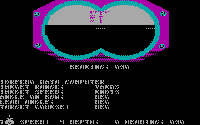
Design: Sid Meier
Publisher: MicroProse
Genre: Wargame
Difficulty: Advanced
While his decision may seem strange in hindsight, keep in mind that virtually every other strategy game designer was trying to do the same thing. Why? Simple: Avalon Hill and SPI board games were what the first generations of computer game designers had grown up with. And for all their flaws, the best of these games – such as Afrika Korps, Third Reich, and Terrible Swift Sword – were bona fide classics well worth emulating.
Theoretically, with the computer handling all of the tedious bookkeeping chores, NATO should have been much simpler than a board game to play. It wasn’t. Rather than formulating a strategy to keep the Warsaw Pact from overrunning Europe, most players spent time fighting the steep learning curve. Reviewers at the time evidently loved the game, but I suspect most of them were intimidated.
What NATO taught Sid was that complexity is never a substitute for depth. Later, Sid wargames would either be much simpler – and more fun – or (as with Civilization) would make their complexity more digestible with easily understood subsystems.
I played a lot of those kinds of games when I was a kid – the hexes and counters games – and I wanted to do one on the computer. I did NATO Commander. I probably learned that that was not a real fruitful direction to go. I think that style of game is OK on the computer, but you lose almost as much as you gain by putting it on the computer. You lose the scope of the map, the ability to take in everything at once. It’s fun to have an opponent there all the time that the computer gives you, but I’m not sure those games are dramatically more fun on a computer than they are on paper. Whereas a game like Pirates or a game like F-15 or a game like Civilization are games that really are only as much fun as they are on the computer.
So the lessons from NATO Commander are probably more negative ones than positive. I thought it was a cool game, but it wasn’t a direction where there was a lot more for me to do there.
Conflict in Vietnam (1985)
Vietnam is a sensitive subject for Americans, even now, which makes it all the more surprising in retrospect that MicroProse would do a game on the subject. Truth is, if the game had been designed by anyone other than Sid Meier, MicroProse wouldn’t have even considered it.
Conflict in Vietnam was designed in the early stage of Sid’s career, which is best characterized as a relentless search for identity. Sid’s enthusiasm, so evident in games such as Sid Meier’s Pirates or Silent Service (both of which he would design in the next two years), was severely dampened here – mainly because everyone associated with the project wanted to treat the subject seriously.
On the other hand, Conflict in Vietnam was more accessible than NATO Division Commander, another high-complexity wargame designed by Sid during this period. It isn’t as accurate a treatment as Nick Karp’s old Vietnam board game (ironically designed about the same time and of similar complexity – you can still find copies in auctions at summer game conventions like GenCon or Origins).
If you’re dying for a campaign-style Sid game, you’re much better off playing the lighter affairs of Crusade in Europe or Decision in the Desert (provided you can find a Commodore 64 emulator). Or better yet, play some of the excellent scenario packs for Civilization II.
I think there are different styles of gamers. I like some element of competition. I don’t need a game that has a score permanently displayed, which winds up as you do better. I like the idea that I can play once and play again and then be able to compare the two times and say, “I’m going to go for a better score or whatever.” So there’s a kind of middle ground of gamers that like some competition, some idea of being able to make progress. There are other gamers that don’t need that to play a game. [In games] like SimCity or Flight Simulator, the model is basically the reward. You’re not being scored, and there’s not a real sense of competition. Then there are gamers on the other side who play games where scoring is the only thing – a Mario Brothers or something – where basically you’re just going for the next score, the next level, the next whatever. I don’t think there’s a right or wrong way. It’s just that there’s a spectrum, and I like games that have some of both.
Crusade in Europe and Decision in the Desert (1985)
Crusade in Europe and Decision in the Desert marked Sid’s departure from his more complex designs such as NATO Division Commander. Despite the fact that the manuals are too long (everyone knows that real gamers demand thorough manuals, then don’t read them), these two titles are actually beer-and-pretzels games that have aged nicely. Problem is, if you don’t have access to a Commodore 64 emulator, you can’t play them (assuming you could stomach the ancient, cartoonish graphics).
The games offered World War II conflict on an easily accessible scale, with minimal worries about logistics and other nonentertaining items. Basically, you accepted your role as Eisenhower or Montgomery and cut to the chase. The interfaces wouldn’t stand up to the Warcraft IIs of today, but they were fairly clean for the time. The campaigns were interesting, and the computer opponents of both games put up a good fight (especially when you take into account the limitations of coding AI in 64K memory).
Both games sold pretty well, but neither was a breakout hit.
Overall, Decision in the Desert was more realistic (mainly because the North African campaign was fairly limited in scope), and Crusade in Europe was more sheer fun. Sid seems reticent about doing this kind of campaign-style game again, but given the recent success of similar games such as Panzer General, you never know.
My approach to game design in general is that I will find a topic, like pirates or the Civil War or civilization, and say, OK, what’s cool about this topic? What are the cool payoffs, and what’s the fun that I want to have? And then I decide what’s the genre that it falls into; what’s the system that will do that.
A good example is Civilization. I knew I wanted a game [of Civilization] to start small, then build into this big, kind of Risk/Empire conquer-the-world kind of game.
My first approach was to take the SimCity real-time genre and say I’ll do it in this genre. But after I played for a while, I decided this doesn’t work. I need a different system to get the effect that I want. I went back to more of an Empire kind of approach.
I don’t go about writing games to fit into a genre, make the topic fit the genre. It’s more find the topic and figure out what style of gaming, what genre, is going to make it fun. That was certainly true of Pirates!, that I knew I wanted all the key scenes of a pirate movie: the ship battle, the sword fighting, all the characters. But I realized that it doesn’t all fit into one genre. We needed some adventure, we needed to travel, we needed action scenes, we needed all these different things. So I did it as a hybrid basically because that was the only way to get all the cool things that I thought needed to be in the game into the game.
Sid Meier’s Pirates! (1987)
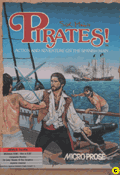
Design: Sid Meier with
Arnold Hendrick
Publisher: MicroProse
Genre: Action/Adventure/
RPG/Strategy/Wargame
Difficulty: Easy
It debuted on the Commodore 64 and soon became one of the most popular games ever on the Macintosh. Sid Meier’s Pirates! reached its creative peak, however, on the Amiga, where its sumptuous graphics and full stereo soundtrack – featuring a marvelous pirate soundtrack by Jeff Briggs – weren’t surpassed on the PC for almost a decade.
Ostensibly, it’s an adventure/role-playing game, where you attempt to carve out a nefarious reputation for your pirate captain before retiring or meeting with an untimely end. But at times, Pirates! is also a fast-action game, where you engage in sword fights (with your choice of refined rapier, basic longsword, or bloody cutlass) and exchange broadsides between vessels on the high seas. There is a definite strategy element, as you explore the Caribbean, traveling from one port to another in search of gold to plunder and enemies to overcome. Pirates! is even a real-time wargame – several years before these surged in popularity – as you maneuver your scurvy dogs over grassland, hills, and even swamps to approach walled towns, fighting everyone from townspeople armed with farm implements to elite Spanish pikemen and cavalry.
To this day, Pirates! is unique in offering the right balance of real-time and turn-based gaming. If you are into resource management, you can handle your ship’s inventories and pore over virtual charts at leisure before leaving port, but once the anchor is raised, the game keeps moving as you meet one adventure after another.
And as with any great Sid Meier game, there is always plenty to do. Buying pieces of obscure maps may lead you to your long-lost sister or even buried treasure. After meeting with the colony governor to negotiate a Letter of Marque, you can converse with his beautiful daughters, flirting or even proposing marriage via a multiple choice menu.
It’s hard to imagine a game more steeped in enjoyable period flavor – both historical and Hollywood – than Sid Meier’s Pirates! It’s unquestionably the best hybrid game ever designed for any platform, offering something for everyone, regardless of what gaming genre they usually prefer. Unless you’re one of the few remaining Amiga faithful, pick up the Pirates! Gold version for the PC – just make sure to get the patch.
Pirates! just struck a chord with a lot of people. It was pretty unexpected, but I still get people who talk to me about Pirates! and say “When are you going to do another version of Pirates!?” or “That game was a lot of fun.” Pirates! was basically my reaction to the adventure/RPG games that I’d played, and being frustrated with the games that were all about hit points and charisma points and pick up the stick.
For me, that was frustrating. I didn’t want to spend three hours building up my hit points so I could challenge the next opponent. The idea of telling a story was kind of cool. The method it was being done in was very hackneyed. I don’t know whether it came from paper gaming. It seemed to really not be computer-oriented – not what computers could do with adventures. So I did Pirates!. I thought, “This is the way I would like to see an adventure game done.” Forget the points, the mathematics – just have an adventure. Go do things and wander around this world.
It was also a reaction against what I call the pick-up-the-stick games. You know, go in a room, look at the lamp, look at the drawer, open the drawer, close the door, turn on the light. Pirates! was a menu game; you had four options. You didn’t have to worry about exhaustively investigating your environment for an hour before you had any fun. The idea was that there were three reasonable things you could do – pick one and move on. So it was kind of an adventure game for people who didn’t like adventure games in a way, who weren’t really into that technology of adventure gaming. A lot of people seemed to respond to that.
Red Storm Rising (1987)
Before Tom Clancy became a weapons expert, political analyst, TV mogul, and a veritable network unto himself, he was just a storyteller – one talented enough to transform the arcane sensibilities of modern warfare into something fascinating for the average Joe. And while Clancy never became a hard-core gamer, Tom liked games; in particular, he liked the idea of turning his novels into games, for which the combat-rich Red Storm Rising novel was perfectly suited.
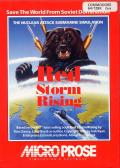
Design: Sid Meier and
Arnold Hendrick Publisher: MicroProse Genre: Simulation Difficulty: Intermediate to Advanced
In 1985, TSR (the Dungeons & Dragons folks) sold some 60,000 copies of a Red Storm Rising board game (which is still worth picking up, if you’re interested) based on a land conflict between NATO and Warsaw Pact forces in Europe. So, when MicroProse signed the contract with Clancy for a computer title, Sid wanted to do something different: a modern naval game.
In Red Storm Rising, you portray a submarine captain, but all of the cozy arcade accouterments from Sid’s earlier Silent Service are replaced by a gritty techno-realistic look. The game is played over a series of multiple sonar arrays, together with torpedo tracking and threat displays – enough grids to make you swear off graph paper forever – but it also offers plenty of eye candy, in the form of sinking ships and missile launches, to keep you coming back for more. The missions are the most varied of all Sid Meier sims: You stalk Soviet ICBM subs under the Arctic ice cap; stop your enemy from landing commando forces in Iceland; slip just offshore of the Karelian peninsula and level a land base with Tomahawk missiles; even get into “knife fights” with hunter-killer submarines.
Tom Clancy is so expensive now as to render the question of a Red Storm Rising II moot, which is a real shame. More recent submarine simulations, such as SSI’s Silent Hunter, may offer more photo-realistic instrument displays, but nothing can quite capture the feel of involvement and psychological realism found in Red Storm Rising.
Each time Red Storm Rising was ported to another platform, it was tweaked to take advantage of each platform’s strengths. If you use headphones when playing the Amiga version, for example, the sound quality is such that you learn to identify enemy vessels by their unique propeller noises – you feel almost like a real sonar operator! And as you win or lose missions, the fate of the free world hangs in the balance. A bit melodramatic? Perhaps, but it’s a wonderful way to design a game.
Red Storm Rising was the only license I’ve done. We wanted to do a modern submarine simulation, especially after Silent Service had been pretty successful. When I read the book Red Storm Rising, I really enjoyed it. I was really leery of doing licenses, but Bill (Stealey) kind of convinced me. It was actually not as complicated as we thought, but we had to kind of be approved by Tom Clancey. So we went one day to Tom Clancey’s house, having no idea what to expect. He was a very friendly guy. Bill of course went into fighter pilot mode and told him all his war stories, and basically Tom just wanted to make sure we were OK guys and would do an OK job with this product.
Tom had written Red Storm Rising with Larry Bond, who was kind of the hard-core, harpoon, really knew the nuts and bolts of submarines and things like that. So he was the guy I basically dealt with most. It was a productive and a good relationship, but I did get a sense [for the first time] that I really prefer to work on my own and make the final decisions. We had a good relationship with Red Storm Rising, but I could see how with a license, things would get to a point where you as a designer want to do one thing for gameplay purposes, but the licensee would have other ideas. So I’ve stayed away from licenses since Red Storm Rising.
Red Storm Rising amazed me in that it went too far in the sim obscurity direction. You have a screen with some dots running around and some numbers flashed up and people bought that as…. I mean, I knew what was happening, but the fact that with fairly rudimentary graphics you could convince people that they were in a submarine, and missiles were dropping in the water and circling around searching for them. I gave people a lot of credit for getting it, because I think the actual presentation is on the fuzzy edge of being a little too obscure. But again, if you were into the topic, you really liked it, and a lot of people seemed to enjoy that game. I wouldn’t put it on my top ten list of my games, but I think it was… it took the topic seriously and did the best it could with a pretty obscure topic.
F-19 Stealth Fighter (1988)
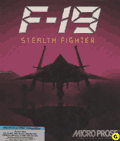
Design: Sid Meier with Arnold Hendrick
Publisher: MicroProse
Genre: Flight Sim
Difficulty: Intermediate
A minority of vocal hard-core flight sim fanatics will try to convince you that anything prior to Falcon 3.0 is closer to a jazzed-up arcade experience than a true simulation. How ironic it is, then, that MicroProse’s later F-117A flight sim hasn’t held up nearly as well as F-19 Stealth Fighter, which was published before the government’s announcement of the real-life F-117 stealth fighter. As with his later Red Storm Rising, Sid Meier showed in F-19 Stealth Fighter that he could make a simulation – using declassified data augmented with a
sound physics model and some shrewd guesswork – that was accurate enough to please the enthusiast and a great enough game to make flight sim fans out of everyone else.
F-19 Stealth Fighter hearkens to an earlier age when a 1MB PC (notably the Amiga) was the hottest gaming machine on the market, and though its gloss is somewhat faded now when compared with more recent Gouraud-shaded simulators, F-19 Stealth Fighter still offers one thrilling ride.
Without the multifunction joysticks and throttles of today, pilots of the mythical F-19 had to manage with keyboard overlays and hot keys; yet the game still provided challenges unique to flight simulations of the day.
Although the F-19 was adequately armed (free-fall and guided bombs, Vulcan 20mm cannon, and over a half-dozen missile types for land, sea, and/or air), the electronic profile and stealth elements were so well done that it was often more fun to avoid a dogfight than to engage in one.
So, even considering the holes in the simulation – keep in mind that the real stealth fighter wasn’t yet built – the game took on the nature of a “thinking man’s sim,” a real departure from the reflex-heavy simulators of the time. The missions in particular were especially well-designed, as they involved sneaking around through a variety of enemy defenses. Perhaps the most intriguing thing about the game was how surprisingly similar it was to actual Desert Storm sorties years later.
I thought Stealth Fighter was a great game. There were times playing that game where I was totally into it. I remember one time floating over Baghdad and going as slow as possible, and I totally believed that I just had to do this or else they were going to pick me up on their radar. It was one of the first games that gave me that Doom feeling of playing on the edge of your seat. It was called Stealth Fighter, so we had to add the stealth effect, but it was really refreshing to me to have a game that wasn’t about destroying 70 planes in one mission. That was an element of flight simulators that had gotten out of hand to me, so this added another dimension.
It was pretty leading edge in terms of 3D technology. It was a time when we were making really neat strides in 3D, and they really had a payoff – they were not only better looking, but gave you more gameplay than you had before. I think these days, 3D’s getting better, in that it looks better, but I’m not sure that it adds a whole lot to gameplay. Which is not to say it’s bad, but I think that in those days, the increases in 3D technology and the better 3D action gave you a better game to play.
The tracking cam was something I’m still proud of. The problem with flight simulators had been that you are basically fighting a dot out there on the screen, but you would read these books about fighter combat, and it’s about all these cool split-S maneuvers and things like that. In a flight simulator, you couldn’t do that, because you couldn’t tell what the other plane was doing. It was either a dot, or for a split second, it was a big plane, and then it would be behind you or whatever. Since we were doing a hi-tech plane, we invented this tracking camera, which, in the corner (of the screen), gave you a view of what the other plane was doing. So, for once, you could tell what the other plane was doing – it’s a dot out there, but I can tell it’s going to the left, so I’m going to anticipate. You’d start to get into actually doing real fighter plane types of maneuvers.
Once we had that, we added all the different camera views. I think we were the first to do a game where you could actually pick among seven or eight different cameras: the camera that rode on your missile, the camera that always kept you and the other airplane in the same shot, the reverse view. We found that just being in the cockpit all the time was not enough information. Those ideas came out of gameplay, but I think they became part of the technology of flight simulators.
Gunship (1997)
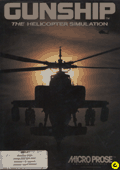
Design: Sid Meier, Andy
Hollis, Arnold Hendrick
Publisher: MicroProse
Genre: Flight Sim
Difficulty: Intermediate
In the late ’80sand early ’90s, flight simulators were where most of the ground-breaking work was being done in computer games – a fact reflected in the sales figures. MicroProse thus built its early empire by becoming the undisputed champion of flight sims, and it was games like Gunship that got them there. The dream design team combined the talents of Sid Meier and veteran strategy/simulation designer Arnold Hendrick with newcomer Andy Hollis (now the head of Jane’s Combat Simulations for Electronic Arts) to produce the first chopper product on the computer to be both a reasonable simulation and an enjoyable game – a feat that seems beyond most of today’s sim designers.
The polygon-filled graphics moved quickly – especially when you consider that Gunship debuted on the 8-bit Commodore 64. It’s rare that you see a sim today largely controlled via keyboard, but Gunship’s keyboard overlay worked brilliantly, offering an easy enough learning curve that the design team didn’t have to skimp on the helicopter feel (can you imagine trying to fit one of these overlays over today’s ergonomic keyboards?). Flight sim veterans and casual gamers alike found the relatively sluggish controls of the AH-64A Apache a refreshing change compared to the reflex-demanding jet simulations of the day.
Obviously, newer simulations have passed Gunship by graphically, but few of them modeled more hi-tech toys – inertial navigation systems, anti-torque tail rotors, 30mm chain guns, flare decoys, radar jammers, and a treasure trove of rockets and missiles, among others – or presented them in such a nonthreatening manner to the would-be chopper pilot.
Gunship was the first sim to offer character continuity through a linked series of missions, with such nice touches as R&R for fatigued pilots and the option to pass on hazardous missions by taking sick leave. Although Gunship spawned a host of imitators, it’s significant that it took Andy Hollis years to finally surpass the original with Jane’s Longbow and Longbow 2, games that match the excitement of Gunship with the increased realism and performance available with today’s PC technology.
It was fun doing a helicopter game after doing all those airplane games; a whole different flight model was a fun thing to do. I think of Gunship as something where we did a lot of 3D work. I remember sitting with Andy (Hollis) and trying to get this frame rate to come up on a 4.77 IBM PC. We did a calculation and we figured we’d only draw the screen physically three times a second. We really put a lot of work into 3D speed in that game. I remember sitting with Andy and him saying, “Sid, I need one more optimization run. I know you can come up with one more idea.” We’d brainstorm about how we were going to get some speed out of this 3D stuff or how could we simplify the equation and how could we simplify the drawing. We really pulled our hair out to get a kind of a frame rate that we were satisfied with. In the interest of gameplay, it had to move at a certain speed. We were going to rip stuff out if it didn’t speed up.



